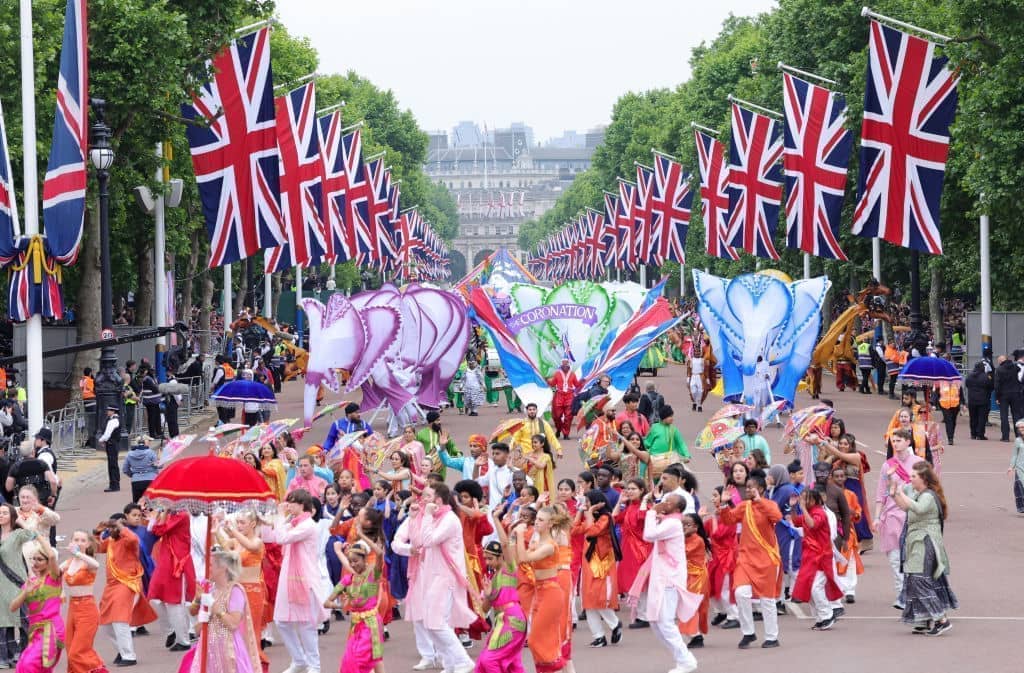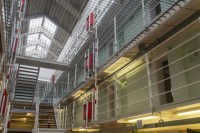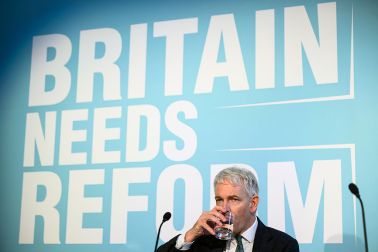Down on the Embankment in London, yesterday, we came upon a peculiar sight: a completely stationary parade. Floppy-hatted drummers, with a vaguely heraldic look, marched on the spot in columns. Behind them there were equestrian forms, mid-leap, with their lower halves made to look like marble statues and their upper bodies made of clockwork, trailing a huge horse’s head drawing behind it a purple crown the size of a gasometer. Behind them, phalanxes of teenagers dressed as swans, and behind them phalanxes of teenagers dressed as some sort of fish, twirled and flapped to the famous patriotic song ‘Who Let The Dogs Out?’. Someone had let the dogs out, an’ all: another team of T-shirted youngsters were ‘walking’ a Battersea’s-worth of life-sized model corgis on sticks around them.
Behind them, there were gaily-painted cyclists on top, for some reason, of Land Rover Defenders. Behind them in turn was a great open-topped lorry painted all sorts of colours atop which people painted in the same sorts of colours were breakdancing and – good god – bouncing on a trampoline. And behind them were some ladies done up as giant peacocks, or fairies, or something. Far up ahead you could see a Brobdingnagian mechanical model of a blonde woman waving and blinking. I couldn’t make out if she was intended to represent Demeter, or the young Queen Elizabeth, or Millicent Fawcett, or Mary Seacole, but she looked a bit like the robot in Squid Game and she freaked my 8-year-old right the hell out.
‘Is this for the Jubilee?’ asked my 12-year-old, ‘Or is it Pride?’ Pretty sure it’s the Jubilee, I assured her – corgis, swans and Land Rover Defenders being more usually associated with this type of queen than that one. And this sort of thing, I went on to explain, is why we’re jolly well not speaking German. She gave me a look and returned to whatever she was doing on her phone. Well, I thought: Gawd bless her Majesty, on this as on all occasions. Finally, after a long period of being stationary, the parade sort of trundled forwards and the songs repeated and the Embankment, or our bit of it, fell quiet again.
The monarchy survives and prospers not because it is majestic, I suspect, but because it is ever so slightly absurd.
The Jubilee is itself an assertion of a link to the past. This scene – when you set aside the historical specificities, such as the booming amplified music – seemed perfectly in keeping with a tradition of pageantry that goes back centuries: here were tumblers, mummers, drummers and pipers, dawdling groundlings and gawping tourists. Give or take a burning effigy of a Pope or two, it was a scene to give Peter Ackroyd a pleasant psychogeographical shudder.
The Jubilee Celebrations have shown, I think, our country’s most attractive qualities: not pomp and circumstance so much as confused enthusiasm and screaming high camp. The monarchy survives and prospers not because it is majestic, I suspect, but because it is ever so slightly absurd. It’s part of our theatrical tradition at least as much as it’s part of our constitutional tradition, and there’s probably a case to be made that the Royals were never so triumphantly themselves as when hosting It’s A Royal Knockout.
I mean, consider how close to pantomime these celebrations have been – complete with the Prime Minister, essaying the role of King Rat, being booed by the crowds, and the Duchess of Sussex deftly skirting the casting call for wicked stepsister. Even the apparent solemnities of the Jubilee Trooping the Colour had a slight flavour of the gingerbread soldiers in The Nutcracker. Here’s one of the princes capturing the heart of the nation in a sailor-suit. Here are Rod Stewart and Diana Ross belting out the oldies. Here are the Duke and Duchess of Cornwall playing themselves on EastEnders – when through the 1990s we followed the twists and turns of their lives as if they were EastEnders.
Her Majesty herself even got in on the act, appearing in a sketch with Paddington Bear (by now probably the second most beloved icon of our national identity) and revealing that she keeps a marmalade sandwich in her handbag for emergencies. That sketch cut to crowds outside Buckingham Palace pumping their arms in time to the opening bars of ‘We Will Rock You’ by, of course, Queen.
I do not point to all this silliness to deprecate it, but to marvel at it. A gaudy and jokey iconography of the royal person – all swans, crowns, handbags and corgis – is forced through a kaleidoscopic outburst of good-natured national chaos in which Paddington Bear and Her Majesty, polystyrene corgis and ‘Who Let The Dogs Out’, HM the Queen and Queen jostle merrily together. All the while such cheerfully unserious figures as Penelope Keith, Michael Palin and Alan Titchmarsh offer jocund commentary.
It’s probably what earnest Bakhtinians would identify as carnivalesque, but I prefer to see it simply as a sign of a monarchical tradition that is never more uniting and attractive than when laughing at its own eccentricities or tipping a wink to the audience like a principal boy. That’s the thing about us Brits (as I once had to explain to some outraged Russian wedding guests after my best man’s speech): taking the mickey is how we show love.







Comments